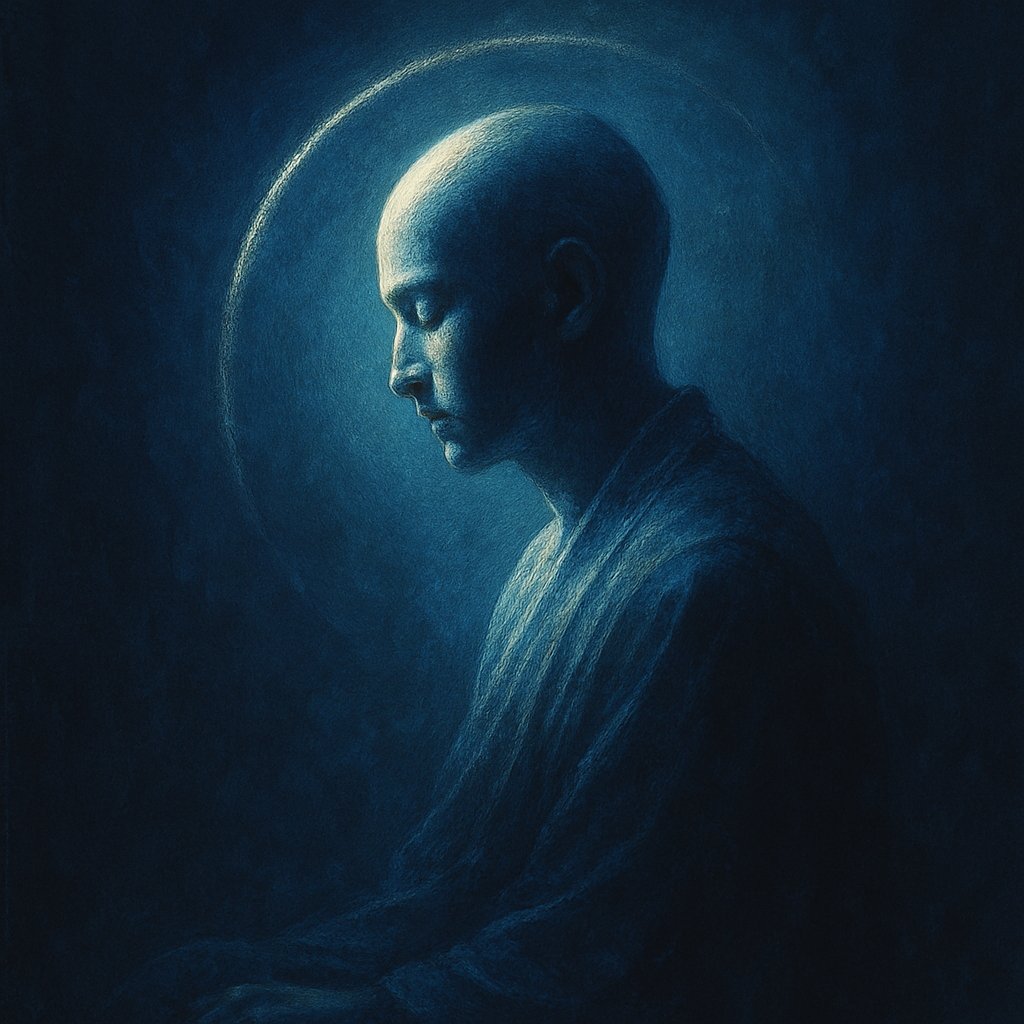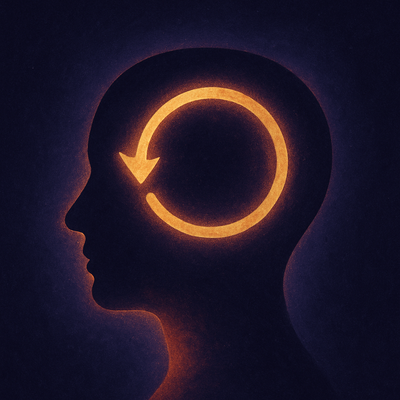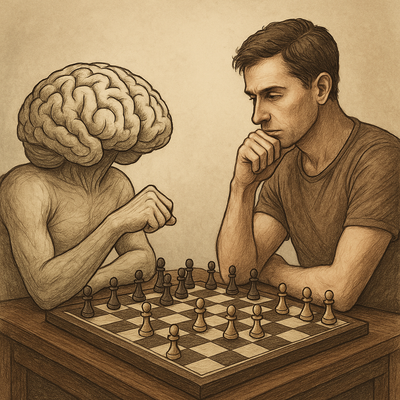After a busy week, on a Saturday morning...
Imagine waking up when everyone else is asleep.
We go into the living room and sit down, it's still in that indistinct silence between night and morning.
While we are thinking about making coffee, we notice that something is moving strangely in our mind.
It is as if our mind is still working while our body wants to rest.
We are silent, but it is still saying something; judging, remembering, comparing...
While we think we are "resting", our mind is actually talking to itself.
It makes evaluations without our permission, echoing in the silence.
It is as if when we are silent, instead of the world going quiet, there is an internal voice that wants to make us hear something.
In this article, we will talk about where that voice comes from, why it won't shut up and how we can transform it.
Because sometimes freedom begins not with freedom from the chains of the external world, but with freedom from the echoes of our own minds.
Philosophical Perspective
Heidegger: Silence is the Purest Form of Being
When we are silent, the mind usually does not stop.
A voice from within begins to speak, sometimes listing the past, sometimes regrets, sometimes to-do's.
While we seek silence, our mind takes its own stage.
Then we realize the difference between "real silence" and "mental silence."
Heidegger offers us a different perspective at this point.
Silence, according to him, occurs not only when the outside world is silenced, but at that inner stop where one comes into contact with one's being.
Because thought (however necessary it may be) inevitably draws a veil in front of being.
As soon as we define something, we categorize it and thus lose the ability to see it "as it is".
This is why Heidegger says that "silence is the purest form of being."
Silence is the courage to let things be as they are.
To "let things be", to "observe things as they are, as they are", without adding any interpretation, label or judgment.
When the mind is silent, the origin of that inner voice gradually becomes visible.
In fact, that voice is not a self speaking, but a state of being trying to make sense.
This is precisely what Heidegger calls "the language of being"; a stream of consciousness is possible without thought.
Silence, in other words, is not a thoughtless void; it is the awareness underneath the thought.
Therefore, that inner voice does not need to be silenced; only the silence behind it needs to be recognized.
Because silence is not suppression, but listening.
As we listen, we realize that the voice is not really us, that it is only the echo of being.
Heidegger's understanding of silence does not suggest fighting the inner voice, but a profound form of hearing it.
For true silence is the moment when being, not the mind, speaks.
Lao Tzu: "He who knows does not speak, he who speaks does not know."
This short but striking sentence by Lao Tzu in the Tao Te Ching has been describing the knowledge of silence for thousands of years.
The person he calls "the knower" is the one who grasps the truth not through words but through direct experience.
Because truth narrows the moment it is defined; it is limited the moment it is expressed.
This is why the knower does not speak, because words cannot fully replace knowledge.
He only points, but cannot encompass what he points to.
When our minds are quiet, the meaning of this saying becomes clearer.
As the mental noise subsides, we realize that words are often rings around the truth, not bridges to it.
Sometimes "trying to understand" something prevents us from really understanding it.
Sometimes it is necessary to let the water settle on its own, just like stirring a lake makes it cloudy.
The silence that Lao Tzu teaches is not a passive silence.
It is a silence that listens attentively.
It is a silence that listens to the order of the universe itself, to the flow of the Tao.
When the mind speaks, it divides, interprets, separates.
But when it is silent, it becomes part of the whole, like the river merging into the sea.
In those moments when the inner voice does not stop, the meaning of this teaching becomes even more visible.
It is not to drown it out, but to listen to the flow beneath it.
Because we are not the source of that sound; it is part of the Tao, an echo of existence itself.
As we listen to the silence, the meaning of that sound becomes audible, not its noise.
"The knower does not speak," says Lao Tzu, because the mind that tries to explain the truth pushes it away.
But to say "the knower is silent" is not to suppress the truth, but to become one with it.
Not speaking is not an escape, but an awareness that has become wisdom.
Perhaps the reason why the inner voice does not stop talking is because we are always trying to silence it.
But the wisdom of silence lies not in silencing it, but in learning to listen.
Krishnamurti: Silence is the Action of Consciousness, Not of the Mind
According to Krishnamurti, true silence is that rare moment when thought is silent but awareness remains wide open.
When the mind is silent, most people think it is "nothingness."
But Krishnamurti says:
"Silence is not emptiness; it is the state of being aware of all existence."
This difference is critical.
When we try to silence the mind, we are actually fighting thought again.
"I must be silent, I must not think," we make silence a duty.
But thought cannot be suppressed by thought.
True silence arises not by silencing the mind, but by being aware of the mind.
This is precisely the "thought observation" so often referred to in Krishnamurti's teachings:
When a thought arises, not suppressing it, not explaining it, just noticing it.
It's like watching a cloud pass across the sky.
No judgment, no interference.
And in that moment, silence appears spontaneously.
This silence is not passive; on the contrary, it is alive and awake.
It is the action of consciousness, not of the mind.
Because consciousness does not think; it only sees.
And this seeing carries a transformative power.
Thoughts dominate unless they are noticed; the moment they are noticed, they begin to dissolve.
Silence is the natural result of that dissolution.
When the hum of the mind stops, what emerges is not "emptiness" but the naked awareness of consciousness.
At this point, silence is not a goal, but a side effect - a side effect of awareness.
Just as water becomes reflective when it is still, the mind becomes clear with awareness.
Krishnamurti summarizes it this way:
"When the mind is completely silent, only intelligence remains."
This intelligence is different from knowledge; it is not learned but a direct intuitive perception.
Thus Krishnamurti's silence is not a thoughtless darkness, but rather a state of light beyond thought.
And perhaps that is why the real transformation of that inner voice we asked about at the beginning of this article begins here:
not by silencing it, but by learning to listen to it through silence.
The Meaning of Silence in the East and West
Silence, although it is referred to by the same word in every culture, does not point to the same truth.
In the West, silence is often perceived as a lack, the absence of something;
In the East, it is a fullness, a state of self-sufficiency.
In the Western tradition, especially with Cartesian thought, "thinking" became the proof of being:
Cogito, ergo sum - "I think, therefore I am."
In this view, silence is like a space where there is no thought and therefore existence is suspended.
If the mind is silent, who will speak?
Since the self is defined by thought, silence creates almost an emptiness, a fear of "nothingness."
But in Eastern philosophies, especially Taoism and Zen, silence is the opposite:
It is not the absence of thought, but the fullness of being.
For thought is a ripple on the surface of truth; when the water is stilled, all the depth beneath becomes visible.
Lao Tzu's saying "he who knows does not speak, he who speaks does not know" is the essence of this understanding:
True wisdom is so full that it does not need words.
Silence here is not passivity, but pure being itself, a state in which consciousness, not thought, speaks.
Zen masters call it "empty but full":
Empty, because the mind is no longer filled with concepts.
Full, because consciousness is fully grounded in the present.
This fullness can be felt in a tea ceremony, a breath in and out, or even just the sound of overflowing water.
Whereas in the West silence is often seen as a pause,
in the East silence is the fullness of being.
Perhaps this is why Western people want to fill the silence and Eastern people want to get lost in it...
But both point to the same place.
Silence is both a mirror of absence and a mirror of infinity.
As one flees from it, the other becomes one with it.
And perhaps balance is found in the middle of these two conceptions of silence, in that thin line where thought ends but consciousness does not extinguish.
Scientific Perspective
Brain Activity in the Mind's Silence
Scientists have long thought that silence - "doing nothing" - creates a passive state in the brain.
But over the last two decades, neuroscience has turned this idea on its head.
Silence is a moment when the brain reorganizes, not stops.
Functional magnetic resonance imaging (fMRI) studies have shown that the brain's "default mode network" (Default Mode Network, DMN) slows down significantly during deep meditation, mindfulness exercises, or simply sitting quietly. (1*)
This network is the center that governs the brain's internal chatter:
Mental scripts such as self-perception, remembering the past, planning for the future, thinking about how others see us, etc., are all produced here.
In other words, the so-called "inner voice" is actually neurobiological background music.
When this network goes silent in silence, something interesting happens:
The mind goes silent, but the brain is fully awake.
Research shows that new patterns of connections are formed between the prefrontal cortex, insula and anterior cingulate cortex, regions of the brain associated with attention, emotional balance and mindfulness. (2*)
That is, the volume of thought decreases and the volume of mindfulness increases.
In long-term meditation research by Sara Lazar of Harvard University and colleagues, eight weeks of regular silence and mindfulness practice was found to increase the brain's gray matter density, particularly in prefrontal regions. (3*)
This region is associated with decision-making, self-awareness and emotional balance.
In other words, silence is not a rest for the mind, but a reorganization process.
EEG measurements also show that alpha and theta waves are strengthened in moments of deep silence. (4*)
These waves are associated with a state of consciousness that is "relaxed but alert".
Neither completely asleep nor completely aroused.
Just like the state of aware silence Krishnamurti describes:
The mind is quiet, but consciousness is alive.
Modern neuroscience describes this state as "active silence".
It looks outwardly like inaction, but inwardly it is a moment of tremendous coordination.
The brain aligns itself in silence, like a musician tuning his instruments before entering an orchestra rehearsal.
And perhaps this is why silence is not only a spiritual but also a cognitive cleansing.
Because as the chains of thought loosen, the brain reestablishes its internal harmony.
When we are silent, it seems that we are doing nothing, but our brain is preparing the ground for the transition from echoes of the mind to the clarity of consciousness.
So when the voice of thought is diminished, the voice of awareness is raised.
When the brain is silent, a deeper consciousness is actually awakened.
Mental Noise and the Silent Space of Creativity
Modern neuroscience, Silence is not just a moment of relaxation, it is the birthplace of creative thinking.
Stanford University's David Eagleman says the brain is actually at its most productive during moments of "seeming idleness". (5*)
He says creative ideas come not during organized thinking, but when the brain's background processing power kicks in - when the mind is quiet.
Eagleman sums it up this way:
"When the mind is quiet, thought comes from deeper, not surface, sources."
fMRI scans support this idea.
In moments of mental silence, interaction between the prefrontal cortex and the default mode network decreases, while free and unexpected connections are made between larger areas of the brain. (6*)
Silence, in other words, literally creates a "creative space", a space where ideas can collide randomly.
Similarly, Andrew Newberg, in his research on meditation and deep silence, shows that the state of silence increases not only individual peace of mind but also the capacity for empathy. (7*)
Newberg suggests that silence reduces the sense of boundary between "self" and "others" in the posterior parietal cortex region of the brain.
This means both a more emotionally open awareness of others and a biological bridge between creativity and empathy.
In short, silence is not only a ground for inner stillness, but also for cognitive clarity and emotional depth.
The Noise-Canceling Property of the Mind
Consider a "noise-canceling headphone."
It does not suppress noise, it neutralizes it by phase cancellation; that is, it generates the opposite frequency of the external sound and creates silence. In less technical terms, if we think of a sound as a sound of +1 unit, it produces a sound of -1 unit, thus neutralizing the sound.
The mind works by a similar mechanism.
Overstimulation, a constantly stimulated attentional system, creates an internal cacophony of thoughts and feelings mixed together.
But when the mind is quiet, perception becomes clear.(8*)
When the overactivity of the prefrontal cortex is reduced, sensory and emotional data are more accurately integrated.
This is not only a neuroscientific balance, but also a state of existential clarity.
Because the quieted mind not only thinks more clearly; it begins to hear the world more "directly".
Just as we can hear all the instruments in a song only when the background noise is silenced.
Silence is not a diminution, but a purification of perception.
The Real Problem
Fear of Silence
There's an aphorism from a book I read that I liked:
Life is a game that will last until death, and we have to play it all the time, because if we don't we get bored.
Therefore, we are afraid of silence.
But the source of our fear is not the emptiness or the silence itself, but what the silence will show us.
When our mind is silent, cracks appear in the walls of identity that we have built up over the years. Thoughts, memories, labels, social roles... all lose their meaning for a while.
And then the very question we have been avoiding appears:
"Who am I?"
This is why most people will do anything to avoid being alone with silence.
Turn on the TV, check notifications, listen to music, seek conversation.
The modern world has created the perfect antidote to this fear: Constant, unending noise.
Every notification is an echo, every screen is an escape.
Because silence lays existence bare.
There are no ornaments, no distractions, just us and the echo of our mind.
And for many people this nakedness is the hardest thing to endure.
Psychology explains this as "sensory underload anxiety" (9*)
that is, the inner restlessness that comes with a decrease in sensory input.
Because the brain has become dependent on external stimuli over the years, it perceives this lack of stimuli in moments of silence as a threat.
Therefore, suddenly the "inner voice" becomes louder... Regrets from the past, worries about the future, old embarrassments, small-voiced criticisms...
In fact, it is not the world that we silence at that moment, but our self that begins to confront itself.
From a philosophical point of view, this is very similar to
Heidegger's concept of "anxiety."
Anxiety peels away all the layers of meaning from the surface of existence, leaving us alone with ourselves "in the middle of nothingness."
But precisely for this reason, the fear of silence is actually a threshold of awakening.
When the mind goes silent, identity disintegrates, but this collapse is not a loss, it is an opportunity.
Consciousness, freed from thoughts, begins to experience itself directly for the first time.
Thus, the ability to remain in silence is not a passive skill, but the ultimate form of psychological resilience.
For the person who can tolerate silence can also tolerate his or her own inner noise.
The mind that can silence itself is no longer subject to the noise of the outside world.
True courage lies not in speaking loudly, but in being able to listen to one's own silence.
Solution Suggestions
Reducing Mental Noise
Silencing the mind is not "not thinking at all" as many people think.
Rather, it is the capacity to monitor the flow of thoughts.
Silence is not emptying the mind, but noticing how it fills.
Thoughts come one after another. Plans, memories, regrets, dreams...
But the more you try to stop them, the stronger they become.
Because everything that is suppressed is waiting for an opportunity to come back.
So the solution is not suppression, but witnessing.
Imagine a seat in the mind:
When we sit there and watch the thoughts pass by, at some point we realize that we are not those thoughts; we are the awareness through which they pass.
It doesn't require long practices, retreats, monasteries to experience this.
It's enough just to create 3 minutes of conscious silence during the day.
No music, no phone, no talking.
Just noticing.
Not trying to stop the thoughts, just letting them come, saying "okay, you're passing through".
It can be uncomfortable at first.
Because the mind is not used to silence.
But just like muscles get stronger as they work, the mind deepens as it comes into contact with silence.
After a while, that three-minute space becomes a refuge. In that moment, thoughts begin to dissolve; the mind gradually calms down as it listens to the echo of its own noise.
This silence is not a passive emptiness, but an active space of transformation.
To remain in silence is not to run away; on the contrary, it is the bravest form of confrontation.
Because in that silence we no longer encounter anyone, but only ourselves.
And we realize that thoughts come and go, but we are always there.
Awareness remains the silent witness behind all the voices.
Conclusion and Message to the Reader
Silence is not a goal to be reached; it is the doorway to an inner threshold.
There is a fine line between thought and awareness, rather than the experience of silence.
When the mind is silent, wisdom remains, not knowledge.
Because the concept of "knowing" is no longer a data learned from the outside, but an intuition born from within.
In those moments, the right answers are not sought because the questions themselves are resolved in the silence.
In that silence, there is no need to do anything anymore; effort is dropped, resistance is dropped.
Only pure awareness remains.
No echo of the past, no rush of the future...Just the depth of the present moment...
Perhaps true freedom begins in that fleeting moment when no thoughts drag us along.
Because in that moment consciousness, not the mind, is in charge.
And there, silence is no longer something to fear; on the contraryit is the simplest state of being.
Throughout this article we have treated silence not as a lack but as an inner space. In the next step, we will cross the threshold of this silence and turn to the profound question where consciousness and freedom intersect:
"Does true choice begin when the mind is silent?"
In the next article, we will pursue this question. We will go deeper into the self and try to unravel who we are and remember who we are not.
We will journey to the place where the mind is silent, but consciousness speaks.
Till then...
Listen to the silence, even if only for a few moments.
Maybe the voice you hear there will be your own at last.
And as always, stay in love!
Source
- Raichle, M. E. et al. (2001). A default mode of brain function. Proceedings of the National Academy of Sciences, 98(2), 676-682.
- Brewer, J. A., Worhunsky, P. D., et al. (2011). Meditation experience is associated with differences in default mode network activity and connectivity. PNAS, 108(50), 20254-20259.
- Lazar, S. W. et al. (2005). Meditation experience is associated with increased cortical thickness. NeuroReport, 16(17), 1893-1897.
- Cahn, B. R., & Polich, J. (2006). Meditation states and traits: EEG, ERP, and neuroimaging studies. Psychological Bulletin, 132(2), 180-211.
- Eagleman, D. (2011). Incognito: The Secret Lives of the Brain. Vintage Books.
- Beaty, R. E., Benedek, M., Silvia, P. J., & Schacter, D. L. (2016). Creative cognition and brain network dynamics. Trends in Cognitive Sciences, 20(2), 87-95.
- Newberg, A., & Waldman, M. R. (2010). How God Changes Your Brain. Ballantine Books.
- Goldin, P. R., & Gross, J. J. (2010). Effects of mindfulness-based stress reduction (MBSR) on emotion regulation in social anxiety disorder. Emotion, 10(1), 83-91.
- Zuckerman, M. (2008). Sensation Seeking and Risky Behavior. American Psychological Association.






